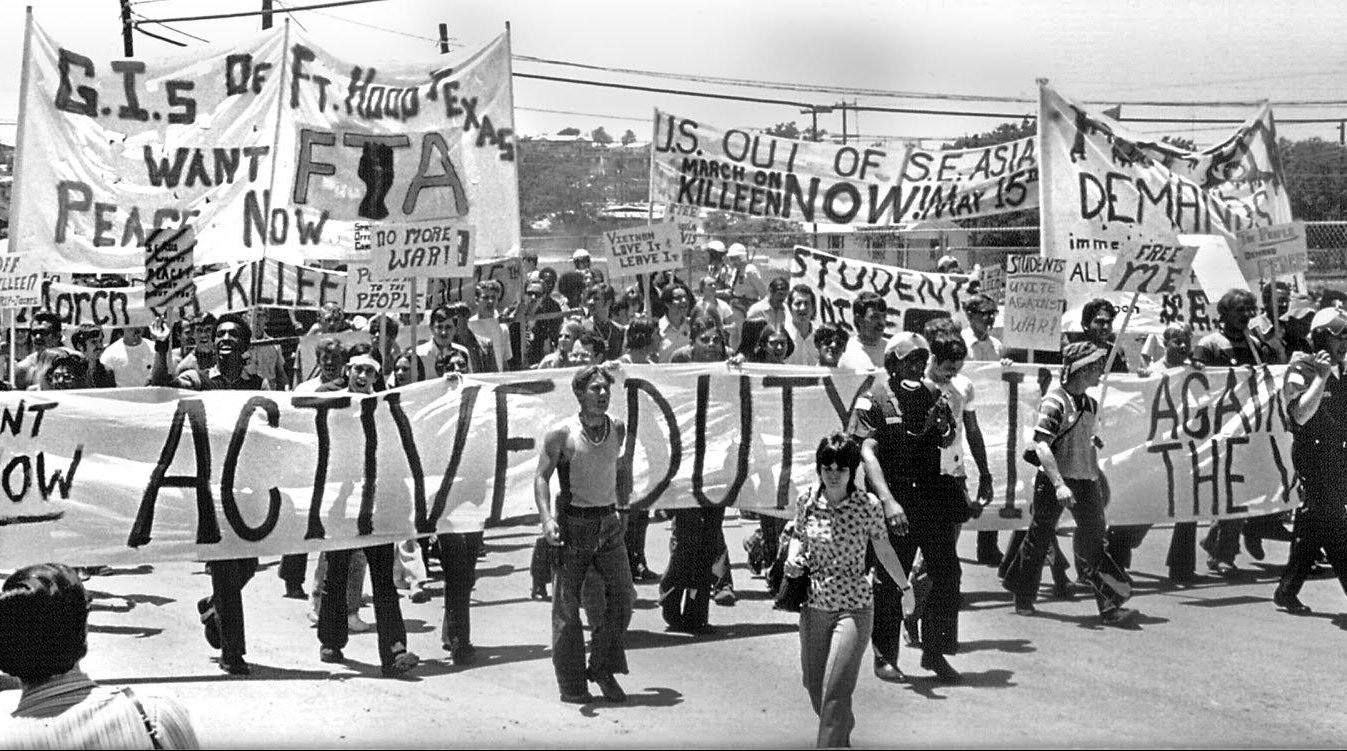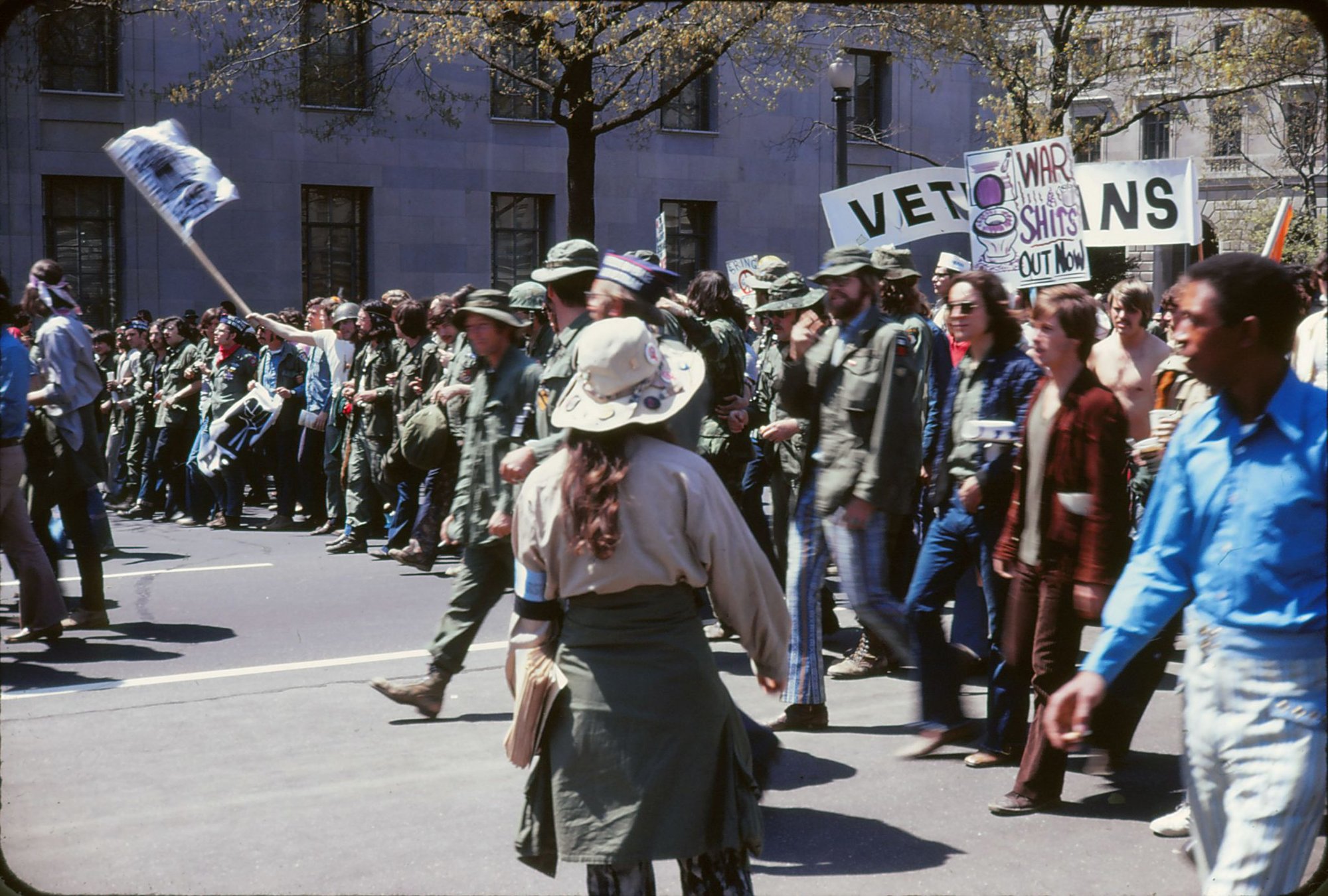
Armed Farces Day antiwar demonstration at Fort Hood, Texas, 1971. Photo courtesy of Wikimedia Commons.
The year was 1967. Buffalo Springfield had just released “For What It’s Worth,” a folk-rock song that described an altercation with the police on LA’s Sunset Strip, which later became an anti-war protest anthem. The counterculture generation of the 1960s through the 1970s preached peace and freedom of expression, and their views challenged the US military’s involvement in the Vietnam War.
Early on, some soldiers began turning against the war effort. Capt. Howard Levy, a 30-year-old Army doctor and dermatologist, was court-martialed and imprisoned for 26 months for refusing to provide medical training to Army Special Forces soldiers. Master Sgt. Donald Duncan, a 10-year veteran of 5th Special Forces Group, was also disillusioned over the reasoning as to why the US was fighting in Vietnam.
“I don’t think Vietnam will be better off under Ho’s brand of communism,” he said, in reference to Vietnam’s President Ho Chi Minh. “But it’s not for me or my government to decide. That decision is for the Vietnamese. I also know that we have allowed the creation of a military monster that will lie to our elected officials, and that both of them will lie to the American people.”

While the military and government officials demonized civilian activists as “hippies” and outspoken active duty service members as radicals, the latter viewed their fringe cause as righteous in the name of counterculture. This became known as the “GI Movement,” and their revolt played on the rising sentiment of division happening in the climate of the country at the time.
Fred Gardner, a Harvard-educated freelance journalist and Army veteran, shared the same beliefs and personal attitudes that existed in California’s progressive circles at that time. While he sat in a coffeehouse in San Francisco, he decided to act in the wake of the GI Movement that had since made the national headlines. He booked a plane ticket to Columbia, South Carolina, to start the UFO Coffeehouse near Fort Jackson, one of the largest US Army bases.
“The UFO became a place where soldiers could gather and talk openly about their worries and frustrations, without the military brass around,” Gardner recalled. It was a place that “not just black and white but students and soldiers” could share.

Soon more GI coffeehouses sprouted around military bases in the United States. The Oleo Strut outside Fort Hood in Killeen, Texas, acted as a sanctuary open to any of the 20,000 soldiers based there.
“The name Oleo Strut came from a shock absorber on a helicopter,” explained David Cline, a peace activist and Army soldier featured in the documentary Sir! No Sir! “The Oleo Strut was a place where you go there and they sold sodas, they had a record player with all the latest rock records, and underground papers.”
Bruce “Gypsy” Peterson founded the underground newspaper The Fatigue Press with the slogan “By GI’s for GI’s.” It served as the voice to bridge the gap between civilian activists at the Oleo Strut GI Coffeehouse and the soldiers at Fort Hood.
“We used to distribute it clandestinely on base,” Cline said. “We’d roll around and leave bunches of them in barracks and in footlockers at night. If you were caught distributing on base, that was a court-martial offense.”
The scandalous headlines and controversial topics printed on the pages soon prompted a crackdown by the authorities. Peterson was arrested for possession of marijuana, and the judge threw the book at him with an eight-year prison sentence in Leavenworth federal penitentiary. He served just two years, however, after winning his appeal. The underground press was temporarily suppressed, yet the effort had emboldened more newspapers and GI coffeehouses to participate.
The GI Voice, Fed Up!, Lewis-McCord Free Press, Last Harass, Counterpoint, and other underground anti-war newspapers published exposés on poor treatment of prisoners in military prisons, updates of mutinies within the military, political cartoons, and information about protest demonstrations. By the end of their operation, more than 300 newspapers were in circulation.
These hangouts for GIs attracted the attention of Hollywood. While Bob Hope used his platform to entertain troops in South Vietnam on USO tours during the holiday season, telling jokes and using props such as a golf club or pajamas and a bathrobe, the GI Movement stuck to its controversial roots. Jane Fonda and Donald Sutherland, two polarizing actors and figures during the Vietnam War, created an anti-war road show called FTA, based on “Fun Travel and Adventure.” They sang “Free the Army,” but according to Fonda, it actually meant “Fuck the Army.”
From 1968 to 1973, GI coffeehouses were an inspiration to many, and a detriment to society for others. Regardless of whether or not one aligns with their beliefs, the impact of the GI Movement and GI coffeehouses during the Vietnam War is worth exploring further to see the ways in which a divided nation may respond to a crisis.

Matt Fratus is a history staff writer for Coffee or Die. He prides himself on uncovering the most fascinating tales of history by sharing them through any means of engaging storytelling. He writes for his micro-blog @LateNightHistory on Instagram, where he shares the story behind the image. He is also the host of the Late Night History podcast. When not writing about history, Matt enjoys volunteering for One More Wave and rooting for Boston sports teams.
BRCC and Bad Moon Print Press team up for an exclusive, limited-edition T-shirt design!
BRCC partners with Team Room Design for an exclusive T-shirt release!
Thirty Seconds Out has partnered with BRCC for an exclusive shirt design invoking the God of Winter.
Lucas O'Hara of Grizzly Forge has teamed up with BRCC for a badass, exclusive Shirt Club T-shirt design featuring his most popular knife and tiomahawk.
Coffee or Die sits down with one of the graphic designers behind Black Rifle Coffee's signature look and vibe.
Biden will award the Medal of Honor to a Vietnam War Army helicopter pilot who risked his life to save a reconnaissance team from almost certain death.
Ever wonder how much Jack Mandaville would f*ck sh*t up if he went back in time? The American Revolution didn't even see him coming.
A nearly 200-year-old West Point time capsule that at first appeared to yield little more than dust contains hidden treasure, the US Military Academy said.












